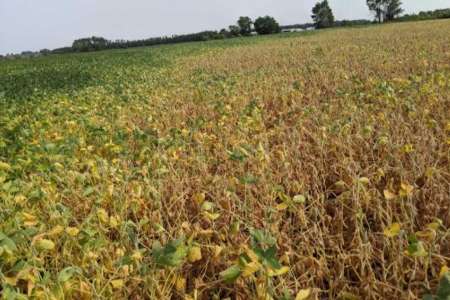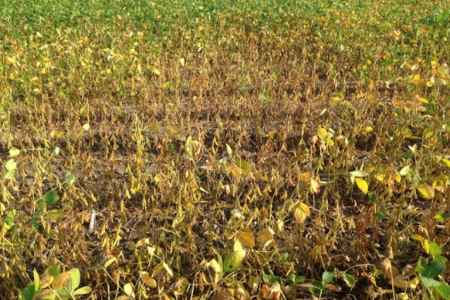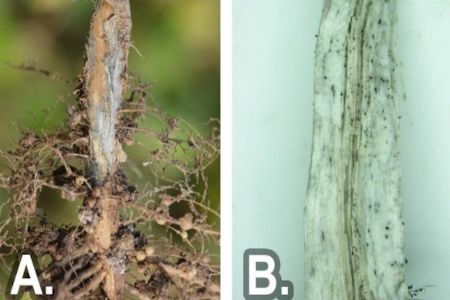By Emmanuel Byamukama
The drought conditions in the past few weeks have led to some soybean fields senescing early (Figure 1). However, some of the early senescing may be due charcoal rot (Figure 2). Moisture stress increases the risk for charcoal rot to develop.
Charcoal rot is caused by a fungal pathogen Microphemina phaseoli. This pathogen survives in soil and in plant residue and infects the plant through roots. The pathogen clogs roots leading to blockage of water and mineral salts being transported.
Infection takes place early in the season, but symptoms develop later in the season, when plants are under stress such as moisture stress.

Figure 1. A soybean field day with plants prematurely turning color due to moisture stress in a sandy/compacted patch area.

Figure 2. Soybean plants dropping leaves prematurely due to charcoal rot.
Symptoms
Charcoal rot symptoms are exacerbated by the soybean cyst nematode presence in the field.
To differentiate charcoal rot from other diseases that my cause early leaf drop, such as sudden death syndrome, uproot a symptomatic plant in the middle of the patch and peel off the tap root skin, small black speckles will be seen (Figure 3-A).
Also splitting the stem will show the black speckles resembling charcoal powder, hence the name charcoal rot (Figure 3-B).

Figure 3. A) A soybean tap root with the skin peeled off to reveal black, ash-like color, a sign of charcoal rot pathogen. B) A tap root split open to show tiny black spots in the taproot tissue, a sign of charcoal rot pathogen.
Management
Charcoal rot is best managed proactively, since by the time symptoms are observed, its too late. Charcoal rot is best management through avoidance of plant stress, such as planting at recommended rates, using no-till which conserves moisture, and weed control to avoid competition.
Crop rotation can help to reduce the inoculum, however, charcoal rot pathogen has many hosts.
No resistance is available for charcoal rot, but there is tolerance among cultivars. Select a good rated cultivar for charcoal rot for fields with a history of charcoal rot.
Source : sdstate.edu